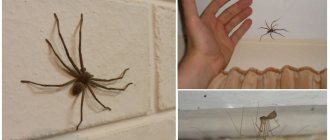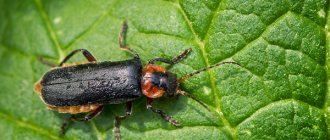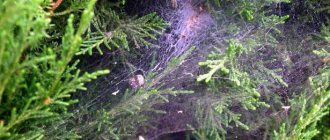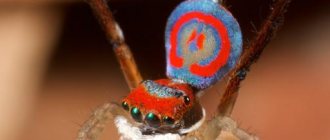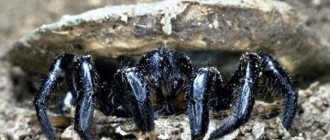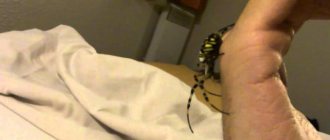How spiders make webs
A large number of arachnoid glands are located in the abdominal cavity of the spider . The ducts of such glands open into tiny spinning tubes that have access to the end part of special arachnoid warts. The number of spinning tubes may vary depending on the type of spider. For example, the very common cross spider has five hundred of them.
This is interesting! The arachnoid glands produce a liquid and viscous protein secretion, the peculiarity of which is the ability to almost instantly harden under the influence of air and turn into thin long threads.
The process of spinning a web involves pressing the spider warts onto a substrate. The first, insignificant part of the released secretion hardens and reliably sticks to the substrate, after which the spider pulls out the viscous secretion using its hind legs. In the process of removing the spider from the site of attachment of the web, the protein secretion stretches and quickly hardens. Today, seven different types of arachnoid glands, which produce different types of threads, are known and fairly well studied.
How do spiders weave webs?
Scheme for creating a web
For example, a weaver spider uses several types of threads to build its web. To create the base, the frame, so to speak, he secretes dry cobwebs. And in order to catch insects, the weaver places a sticky web on the base. The arachnoid thread (a kind of “silk”) is secreted by special glands on the spider’s abdomen. Different glands secrete different types of silk. Depending on the purpose of weaving a web, a spider can use one or another web material.
The round spider begins to weave a web, throwing the thread into the wind. The silk flies in the wind and clings to an object, such as a tree branch, which allows the spider to climb up this thread and add another thread to the original one to make it stronger. After the spider has made the general outline of the web, it spins a thread connecting one side of the web to the other. From the center of this connecting thread, the spider begins to weave another thread, which will connect the center of the web with the side thread.
Interesting: What is the difference between Indian and African elephants? Description, photo and video
Then the spider will lay a lot of connecting dry threads from the edges of the web along its radii to the center, like spokes in a bicycle wheel. Then these “spokes” are woven with circular threads. The result is a spiral dry web. Then an adhesive thread is applied to the surface of the dry web. Now the spider gets rid of the dry web and eats it. The fishing gear is done, the insect snares are ready.
Fun fact: Some webs can be more complex, while others can be simpler.
Composition and properties of the web
Spider web is a protein compound that also contains glycine, alanine and serine. The inner part of the formed threads is represented by hard protein crystals, the size of which does not exceed several nanometers. The crystals are held together by highly elastic protein bonds.
This is interesting! An unusual property of the web is its internal articulation. When hung on a spider's web, any object can be rotated an unlimited number of times without twisting.
The primary filaments are woven by the spider and become thicker arachnoid filaments . The strength indicators of the web are close to those of nylon, but are much stronger than the secretion of the silkworm. Depending on the purpose for which the web is intended to be used, the spider can produce not only sticky, but also dry thread, the thickness of which varies significantly.
Composition of a spider's web
It is the secretion of the arachnoid glands. After release, it stretches and hardens in the form of thin threads. Later they are intertwined and made stronger. Used to form a pattern or as a building material.
What does a spider's web consist of - protein enriched with alanine, serine, glycine. Inside the arachnoid gland, the substance is in liquid form. In the process of passing through the spinning tubes, it hardens and turns into thread.
Where the spider’s web comes from is from warts located near the genitals. A crystalline protein is formed inside the thread, increasing the strength and flexibility of the fibers. Depending on the purpose for which the web will be used, the thickness and strength change.
Interesting!
The strength of a spider's web is close to nylon; it retains tension when the threads are stretched or compressed. An object suspended on a long web can be rotated for a long time in one direction, it will not get tangled, and will not even offer resistance when moving. Thanks to this feature, the spider can hang in the air for a long time, attaching its end to a plant, and also migrate with the help of a web over long distances with the help of gusts of wind.
Spider weaves a web
Functions of the web and its purpose
Webs are used by spiders for a variety of purposes. A shelter woven from a strong and reliable web allows you to create the most favorable microclimatic conditions for arthropods, and also serves as a good shelter both from bad weather and from numerous natural enemies. Many arthropod arachnids are capable of weaving their web around the walls of their burrow or making it into a kind of door into their home.
This is interesting! Some species use webs as transport, and young spiders leave the parental nest on long web threads, which are picked up by the wind and transported over considerable distances.
Most often, spiders use webs to weave sticky trapping networks, which allows them to effectively catch prey and provide food to the arthropod. No less famous are the so-called egg cocoons made from webs, inside which young spiders appear . Some species weave web-like safety threads that protect arthropods from falling while jumping and for moving or catching prey.
Web for reproduction
The breeding season is characterized by the release of arachnoid threads by the female, which make it possible to find the optimal pair for mating. For example, male web-slingers are capable of constructing, next to the nets created by females, miniature mating web laces into which spiders are lured.
Male cross spiders deftly attach their horizontal webs to radially arranged strands of trapping webs made by females. By striking the web with strong blows with their limbs, the males cause the web to vibrate and, in this unusual way, invite the females to mate.
Web for catching prey
In order to catch their prey, many species of spiders weave special trapping nets, but some species are characterized by the use of peculiar web lassos and threads. Spiders that hide in burrow dwellings place signal threads that stretch from the arthropod’s abdomen to the very entrance to its shelter. When prey falls into the trap, the vibration of the signal thread is instantly transmitted to the spider.
Sticky spiral trapping nets are built on a slightly different principle . When creating it, the spider begins weaving from the edge and gradually moves towards the central part. In this case, the same gap between all turns is necessarily maintained, resulting in the so-called “Archimedes spiral”. The threads on the auxiliary spiral are specially bitten by the spider.
Web for insurance
Jumping spiders use web threads as insurance when attacking a victim. Spiders attach a safety thread of the web to any object, after which the arthropod jumps on the intended prey. The same thread, attached to the substrate, is used for overnight shelter and protects the arthropod from attacks by all kinds of natural enemies.
This is interesting! South Russian tarantulas, leaving their burrow home, pull behind them a thin web thread, which allows them to quickly find the way back or the entrance to the shelter if necessary.
Web as transport
By autumn, some species of spiders hatch their young. Young spiders that survive the process of growing up try to climb as high as possible, using trees, tall bushes, roofs of houses and other buildings, fences for this purpose. Having waited for a sufficiently strong wind, the small spider releases a thin and long web.
The distance of movement directly depends on the length of such a transport web. Having waited for a good tension of the web, the spider bites off its end and takes off very quickly. As a rule, “travelers” are able to fly several kilometers on a web.
Silver spiders use webs as water transport. To hunt in bodies of water, this spider requires breathing atmospheric air. When descending to the bottom, the arthropod is able to capture a portion of air, and on aquatic plants, a kind of air bell is constructed from the web, which retains air and allows the spider to hunt its prey.
The spider's catching net was turned into a synthesizer
Model showing the rupture of a spider's trapping web.
Markus J. Buehler / YouTube
Scientists have converted the vibrations of the web into sounds audible to the human ear. An unusual technique allows us to better understand how spiders build trapping webs and use them to collect information about the world around them. In addition, it can be used to create musical compositions. The authors presented their research at the American Chemical Society conference, which is being held online this year.
The spider web is one of the most advanced hunting tools in the wild. Its high effectiveness is partly due to the fact that it is an extension of the host's senses. The spider sitting in the center of the web analyzes the vibrations of the webs and promptly recognizes that prey is entangled in them. In addition, vibrations of the web notify spiders of danger and help them communicate with their relatives.
A team of researchers led by engineer and materials scientist Markus J. Buehler from the Massachusetts Institute of Technology has developed an unusual technique that allows us to better understand how a spider collects information using its web.
At the first stage, scientists carried out laser scanning of the trapping web of the orb-weaving spider Cyrtophora citricola
. Representatives of this species build three-dimensional webs that are not very similar to the flat webs of spiders we are used to. Based on the images obtained, Buhler and his colleagues built a computer model demonstrating exactly how thousands of spider threads are connected to each other. Using the simulation, the researchers were able to monitor in real time the reaction of the trapping net to various forms of physical influence. First of all, they were interested in the vibrations of individual threads. Buhler said the spider web reminded his team of a musical instrument with many strings. This led scientists to the idea of translating the vibrations of the web into sounds audible to the human ear.
The researchers (and the contemporary Argentine artist Tomás Saraceno, who helped them) calculated the vibrational frequency of the spider threads based on their length, thickness, elasticity and the structure of the proteins that make them up. They then assigned specific sound frequencies to the frequencies at which the threads vibrated. Scientists have also established a number of additional rules that determine the correspondence between the vibrations of individual threads and the sounds into which they are converted. For example, the closer the thread is to the observer, the louder it sounds.
As a result, scientists have obtained a kind of synthesizer that can be played by touching a virtual catching net. They recorded several videos showing what different parts of the C. citricola
in response to touch, stretching or tearing. In addition, they sonified the different stages of its construction.
Buhler and his colleagues hope that their technique will help to learn more about how spiders manage to build complex structures from their webs. In addition, it can be used for creative purposes, for example, to create unusual musical compositions.
Data sonification is becoming increasingly popular among scientists and musicians. Although it is not a truly rigorous scientific tool, it can generate interest in various areas of research. In the material “Groove of our datasets” you can get acquainted with several examples of unusual sonifications and hear how elementary particles, microorganisms and tree rings could sound. And recently we talked about stellar music based on astrophysical data.
Sergey Kolenov
Differences in webs by spider species
Depending on the species, spiders can weave different webs, which are a kind of “calling card” of the arthropod.
Round web
This version of the web looks incredibly beautiful, but is a deadly design. As a rule, a round web is suspended in a vertical position and has part of the adhesive threads, which does not allow the insect to escape from it. Weaving such a network is carried out in a certain sequence. At the first stage, the outer frame is made, after which radial fibers are laid from the central part to the edges. Spiral threads are woven at the very end.
This is interesting! A medium-sized circular web has more than a thousand point connections, and its production requires more than twenty meters of spider silk, which makes the structure not only very light, but also incredibly durable.
Information about the presence of prey in such a trap comes to the “hunter” through specially woven signal threads. The appearance of any breaks in such a web forces the spider to weave a new web. Old webs tend to be eaten by arthropods .
Strong web
This type of web is characteristic of nephilous spiders, which are widespread in Southeast Asia. The trapping nets they build often reach a couple of meters in diameter, and their strength allows them to easily support the weight of an adult.
Such spiders catch in their strong web not only ordinary insects, but also some small birds. Research results show that spiders of this type can produce about three hundred meters of spider silk daily.
Spider web hammock
Small, round “coin spiders” weave one of the most complex web designs. These arthropods weave flat webs on which the spider sits and waits for its prey. Special vertical threads extend up and down from the main network, which are attached to nearby vegetation . Any flying insects quickly become entangled in the vertically woven threads, after which they fall onto the flat hammock web.
Web design
The position of sticky droplets on the spider thread (top) and the structure of the droplet.
Each droplet has a glycoprotein core and an aqueous shell, consisting mainly of water and peptides. The design of the web, experts believe, varies depending on the hunting method. To us, the entire web seems the same and consists of completely standard elements. This misleading impression is created because we do not see the web in ultraviolet light.
Human use
Humanity has copied many constructive natural discoveries, but weaving a web is a very complex natural process, and at the moment it has not been possible to reproduce it qualitatively. Currently, scientists are trying to recreate the natural process using biotechnology based on isolating genes that are responsible for the reproduction of proteins that make up the web. Such genes are introduced into the cellular composition of bacteria or yeast, but modeling the spinning process itself is currently impossible.
All about spiders
There are approximately 40,000 species of spiders in the world. The life of each spider is such that in a year it kills approximately 2000 harmful insects that inadvertently fall into its sticky webs. Basically, the victims of many spiders are flies and mosquitoes. If you read everything about spiders, you will know that the size of these creatures, depending on their variety, can be from 0.4 mm to 10 cm
At the same time, the span of the spider’s limbs often exceeds 25 cm. The color and pattern on different types of spiders depends on the structural structure of the integument of hairs and scales, as well as on the presence and localization of different types of pigments. In this regard, such creatures are painted both in a dull monochromatic color and in a bright tonality.
Body structure
These amazing creatures have 2 sections of their body. This is the abdomen and cephalothorax, which are connected to each other by a thin membrane. If you carefully examine the spider, it becomes clear that arachnids have a cephalothorax with a certain division into the thoracic and cephalic parts, provided by a thin groove.
On the head of each spider there are organs such as chelicerae, which are formed by the first pair of limbs; pedipalps, which are formed from the second pair of limbs, eyes and mouthparts. These are the characteristics and descriptions of each representative of the arachnid genus.
What will be interesting for children is that spiders do not have a complete circulatory system. They also don't have blood. It is replaced by lymph.
As for the spider’s brain, it occupies on average a quarter of the total volume in its body.
Spiders have a heart, but it has a peculiar structure and consists of 3 or 4 holes. Through these openings, lymph enters the heart area, after which it flows throughout the body, ending up in the areas between the internal organs.
The respiratory organ of spiders also has a unique structure. The respiratory system of such creatures consists of pulmonary sacs, which are made in the form of plates resembling books.
Each representative of arachnids has 8 legs, and each leg has 6 knees.
Habitat
Spiders are ubiquitous in the world and live on all continents of the globe.
Interesting spiders do not live only in areas where the surface of the earth is hidden under ice all year round.

